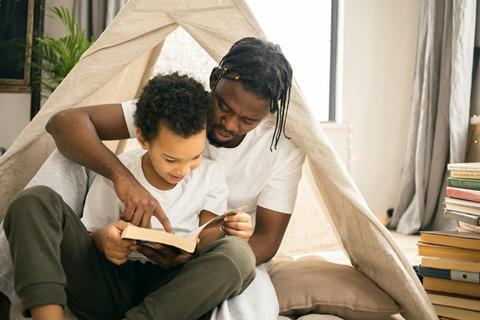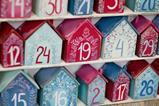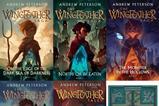Victoria Beech suggests an easy way to make good use of the summer weeks

Would you love to be able to grow faith in your family this summer, but are feeling low on energy and ideas? What if I could give you one simple idea which would help? Read a book together. Yes, just one good book.
How?
Connection
Research into passing on faith has revealed that one of the most important factors in whether our children will continue in faith into adulthood is the connection they have with their parents. Read-alouds are a brilliant and fairly effortless way to do this, creating a time to spend together where the activity is already created by someone else.
This can take the form of a snuggle on the sofa reading a book together, or a moment around a table with drinks and a snack and a quick chapter.
Top tip:
Make it last longer by adding hot food (hot chocolate and a warmed pastry will work - it takes longer to eat!) and a simple activity to keep hands busy while ears are listening. We love colouring, modelling with wax or Fimo or play dough, but anything which isn’t too noisy will work (Lego, I’m looking at you!). Just make sure it’s enjoyable, as obviously a task-based approach is unlikely to create the connection you’re after.
Empathy
For a long while we’ve known that books help us develop empathy. Reading someone else’s view of the world allows us to see it from their perspective, which is exactly what’s needed for empathy in real life. Just listening to a book helps children (and adults!) develop their ability to see from another’s view point, which allows us to have grace and understanding for those different from us. This is an essential skill for life, and one which allows us to be more Christ-like, viewing others as God does.
Top tip:
Look out for books which will stretch your and your children’s world view, something written by someone from a different culture or a different time. Can you find books written by someone black or someone from India? It’s great to have authentic voices in our stories, rather than just a white person’s story about other cultures.
Fun
If you’re already a reader yourself, it’s likely that you have certain books which you read to grow and others you read ‘just for fun’. I would suggest that fun is important to intentionally include in our lives (The joy of the Lord is your strength etc).
Top tip:
Although I love a good classic, I make sure I also read books which are just fun (Of course, they can be both!). One of my childrens’ favourites is The Book With No Pictures by B.J. Novak. It’s guaranteed to get you all laughing.
Read more:
Holy habits for the school holidays: Helping your family stay close to God this summer
Summer glow-up or comparison burnout: The perfection trap for young people
The summer holidays can be great times to bond with your children and develop their faith. Here’s how…
Rest
Good books do more than help us have fun - they give us space to rest. I have often gone back to books I enjoyed in my childhood or early 20s in search of comfort. At my parent’s house, I found two old copies of George MacDonald books which I have re-read many times and I’m now introducing them to my children. Their favourite story in the collection right now is The Princess and the Goblin, which sounds like a simple story, but is really deep and full of lovely characters, adventure and action scenes, as well as being very fairy tale-esque. I recommend it!
Top tip:
Find a book you love and share that with your children! Always have a book on the go yourself and read it at least sometimes when and where you children can see you doing so to model that reading is something you enjoy doing.
Discussion
Reading a book together is a great way to make space for a discussion. You can discuss topics which might be too personal if discussed in reference to yourself, but are easier to discuss about a person in a story. Don’t be fooled by the term ‘discussion’ – it doesn’t have to be a long or formal affair. We use a set of open-ended questions I’ve developed which can be used for any book. We each take it in turns to read and answer a question, then invite someone else to also answer. Then everyone gets to offer their own thoughts if they choose before the nominated person reads the next question. For example, we might ask Who was your favourite character and why? or Which character changed most during the story? Who would you play in a film of this story? This gets us thinking about character and relating to the characters in the book, and can take us down a rabbit hole of discussion, which is perfect! We also ask questions about the plot (e.g. What was the lowest point in the story for you? What would you change in the story?) and themes (Where did fear feature in the story? What was lost in the story?).
Top tip:
Don’t do too many questions. We usually get through two questions each, but it’s all about the quality of the conversation, rather than the quantity of questions! Make sure you answer the questions yourself - this is about connection, not teaching, so the idea is that we get to know what each other think! Finish before anyone gets bored - keep it short and promise to do it again, rather than run out of attention and never want to repeat it!
What to read?
Good books! Nineteenth century educator, Charlotte Mason encourages adults to choose ‘living books’ to read with children. These are books written by one inspiring author, one which draws us in from the start.
Top tip:
Do the One Page Test - read the first page of the book and see if you want to continue, and if you can easily describe to someone else what’s happened on the first page. If you do and you can, this might well be a living book!
I look for lists of books and recommendations by other bookie-parents, but you’ll need to find what works for your family. Here’s a few books we’ve really enjoyed which you might like:
- Badger and Skunk by Amy Timberlake
- The Tale of Despereaux by Kate DiCamillo
- The Princess and the Goblin by George MacDonald
- The Wild Robot by Peter Brown
Christian books are also a good source, although I find often I have to be more picky! I’d recommend steering clear of books which come across too preachy or moralistic, as children are quick to pick up on this, and they feel more like a lesson in godliness than a fun way to connect over a story.
You might like to read some re-told Bible stories. I really like Lucy Rycroft’s new series of stories about women in the Bible, the latest of which is about Rahab. With awesome artwork on every page, these rhyming books are fun and stick closely to the original Bible text. Check them out here
Here’s three Christian series which we’ve enjoyed reading:
- The Ink of Elspet by J.D. Peabody (Book 1 of The Inkwell Chronicles)
- The Bark of the Bog Owl by Jonathan Rodgers (Book 1 of the Wilderking trilogy)
- On the edge of the dark sea of darkness by Andrew Peterson (Book 1 of the Wingfeather Saga)
A quick PS
Please don’t think that because you don’t do read-alouds you’re failing at being a parent. If they don’t work for your family, don’t worry! However, before you move on, have you tried listening together? There’s good audio versions of lots of excellent books, including many I’ve listed here. I use free places such as Libby, Librivox and Borrowbox, accessible using my library card, as well as Audible, which has lots of books included with your membership.
This article was first published in July 2023 and has been re-edited.


































